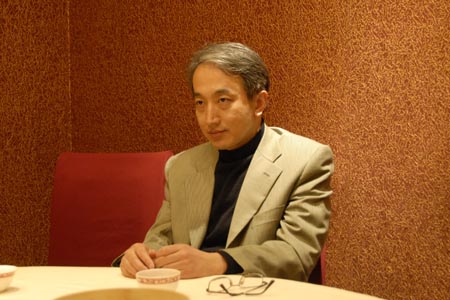|
 |
|
Tan Zheng (LV LING) |
For writer Tan Zheng, 44, the changes in his hometown Shanghai that he can recall start with his childhood memories back in the 1970s, when the city scale was much smaller than today.
According to Tan, places that could be reached within a 30-minute bus ride from the city center were then regarded as the outskirts, while those beyond this distance were definitely countryside.
Taking Tan's alma mater Fudan University as an example, it took him an hour to reach the campus from his home in downtown Luwan District. Not surprisingly, locals did not consider the university part of Shanghai.
"Now, things have changed—it is ridiculous to say that Fudan University is not in Shanghai," Tan said.
But for older generations like Tan's grandmother, Shanghai's boundaries remain unchanged. Tan's current residence is farther from the city center than Fudan University, and his grandmother says she is "returning to Shanghai" after staying at his place for a while.
Tan said his sense of belonging to Shanghai, the largest city in China with more than 16 million residents, is definitely not the same as coming from a tiny town with fewer than 2,000 residents, where acquaintances are everywhere and you are familiar with every corner.
"That's surely not the case here in Shanghai. It is so big that you can only know a small group of people no matter how long you have lived in the city," he said. "There are always streets out there that you have never been to, and you could hardly meet a friend on the street over the next 10 years without making an appointment in advance."
Having been to plenty of cities at home and abroad, Tan believes that the best cities help people meet their need for cultural and tangible products within a reasonable distance. Shanghai, in his eyes, exactly fits the standard and enjoys the most modern feel among Chinese cities, as it offers easy access to so many universities, libraries, museums, theaters, cinemas, and products from all across the country and the world.
However, the convenience brought by modernity, in Tan's view, has both positive and negative sides. On one hand, a more convenient and cheaper transportation system should be developed in parallel with city expansion in the process of nationwide urbanization. "This year, Shanghai has done a good job in this regard, but there is still a long way to go," he noted. On the other hand, garbage, wastewater and gas are on the rise due to the growth in population and daily consumption. "Personally, I think the air quality here in recent years has not been getting better but worse," Tan said. Hence, eliminating pollution and cultivating a better environment remain big challenges for Shanghai.
The haipai culture
According to Tan, a professor in the School of Foreign Languages and Literature at Fudan University, haipai culture (literally "Shanghai-style culture") is not characterized by a certain school of literature or art, but several common features that are shared by Shanghai's cultural products.
Tan said that, judging from a positive point of view, haipai culture is the fruit of cultural exchanges between the East and West that brought in new thinking, concepts and cultural formats full of dynamic and fresh ideas without any existing restraints. That also explains why Shanghai, the pioneer in China's modern publishing and film industries with a relatively free and secure cultural environment, managed to attract a galaxy of talents including renowned writer Lu Xun, novelist Mao Dun, and poet Xu Zhimo to settle down from nearby smaller cities.
Judging from a negative point of view, however, haipai culture is too commercial and lacks profound connotation, particularly in fields related to traditional Chinese culture.
"The buildings standing on the Bund today, better known as the multinational architectural styles, are widely considered a precious cultural and historical legacy for Shanghai," Tan told Beijing Review. "But please don't forget they are symbols that colonialists imposed on us during their regime. Besides, the architectural styles they take on are less than what we imagined.
"To some extent, Shanghainese have every reason to be proud of the abovementioned haipai cultural symbols, but we should also look beyond this and make the culture more profound in the new era," he continued.
The World Expo
What most impresses Tan about this year's World Expo are the changes it has brought to Shanghai's appearance. The city looks cleaner and prettier, and transportation is faster with more traffic lines opened.
Tan believes that through the Expo China should not only present the achievements of its ancient civilization and its rich regional culture and folk customs, but also the progress the country has made in cultural and economic areas in modern times.
In recent years, countries like Ireland, Canada and Australia have been promoting their cultures in China. Unfortunately, China seems to lag far behind them in promoting its culture abroad. The World Expo offers new opportunities for countries to promote themselves in China, and for China to present its cultural products to the outside world, Tan said.
"By the same token, Shanghainese writers can learn from their foreign counterparts in this Sino-foreign cultural exchange event, and also presents their works to the world," he added. |